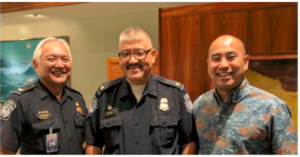2017 September Luncheon
December 29, 2017
Our members learned about U.S. Customs and Border Protection and its duties related to fraud, through presentations by Watch Commander George Minamishin and Supervisory CBP Officer Scott Kikkawa.
With more than 60,000 employees, U.S. Customs and Border Protection, CBP, is one of the world’s largest law enforcement organizations and is charged with keeping terrorists and their weapons out of the U.S. while facilitating lawful international travel and trade. As the United States’ first unified border entity, CBP takes a comprehensive approach to border management and control, combining customs, immigration, border security, and agricultural protection into one coordinated and supportive activity. The men and women of CBP are responsible for enforcing hundreds of U.S. laws and regulations. On a typical day, CBP welcomes nearly one million visitors, screens more than 67,000 cargo containers, arrests more than 1,100 individuals, and seizes nearly 6 tons of illicit drugs. Annually, CBP facilitates an average of more than $3 trillion in legitimate trade while enforcing U.S. trade laws.
In Hawaii, ports of entry in Hawaii include: Hilo, Honolulu, Honolulu International Airport, Kahului, Kona and Nawiliwili-Port Allen. Hawaii also functions as part of a liaison group for carriers in the Asia-Pacific region, training airline personnel to spot potential fraudsters, and provide pre-flight intelligence to CBP if for example they have a high-risk passenger suspected of having fake travel documents. CBP estimates that intercepting one suspected passenger, before he or she gets on a plane, saves the U.S. government $15,000 to $100,000 per passenger, since it can take up to a month to process their case after they arrive in the country.
Fraud Prevention Officers are primarily document examiners, verifying security features for travel documents, which as similar to currency. Officer Kikkawa showed examples of counterfeit attempts and how they were discovered.
When document become too difficult to replicate, in some cases fraudsters find it easier to use someone else’s documentation as their own. Officer Kikkawa tested our members’ facial recognition skills with a game called “Real vs. Imposter”. He showed photos on travel documents, alongside photos of people at the port of entry who may or may not have been the same person. His pro tip was to look at parts of the face – e.g. left ear, bridge of the nose – instead of trying to evaluate each face as a unified entity.
For more information, check out these pages:
- Snapshot of CBP operations
https://www.cbp.gov/sites/default/files/assets/documents/2017-Jun/CBP-Snapshot-06012017.pdf
- A Typical Day in Fiscal Year 2016:
